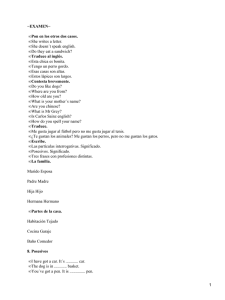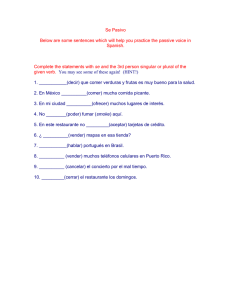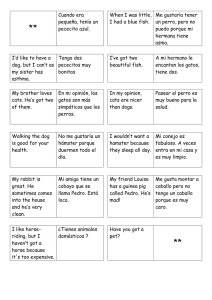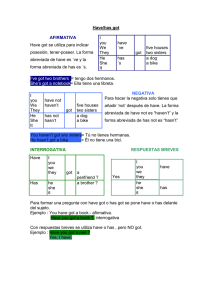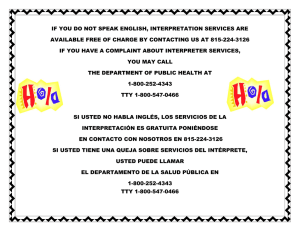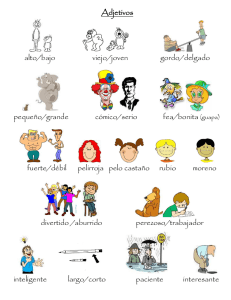Welcome to my world: Revision / Repaso 1. I am, I have got
Anuncio
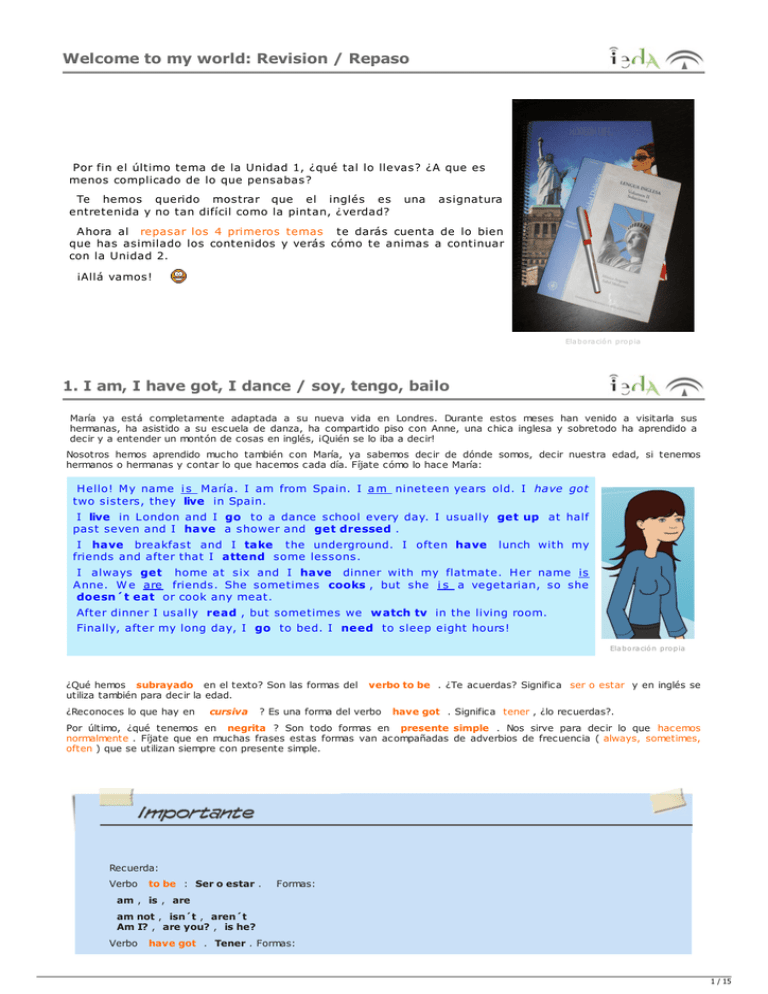
Welcome to my world: Revision / Repaso Por fin el último tema de la Unidad 1, ¿qué tal lo llevas? ¿A que es menos complicado de lo que pensabas? Te hemos querido mostrar que el inglés es una asignatura entretenida y no tan difícil como la pintan, ¿verdad? Ahora al repasar los 4 primeros temas te darás cuenta de lo bien que has asimilado los contenidos y verás cómo te animas a continuar con la Unidad 2. ¡Allá vamos! Elaboración propia 1. I am, I have got, I dance / soy, tengo, bailo María ya está completamente adaptada a su nueva vida en Londres. Durante estos meses han venido a visitarla sus hermanas, ha asistido a su escuela de danza, ha compartido piso con Anne, una chica inglesa y sobretodo ha aprendido a decir y a entender un montón de cosas en inglés, ¡Quién se lo iba a decir! Nosotros hemos aprendido mucho también con María, ya sabemos decir de dónde somos, decir nuestra edad, si tenemos hermanos o hermanas y contar lo que hacemos cada día. Fíjate cómo lo hace María: Hello! My name i s María. I am from Spain. I a m nineteen years old. I have got two sisters, they live in Spain. I live in London and I go to a dance school every day. I usually get up at half past seven and I have a shower and get dressed . I have breakfast and I take the underground. I often have lunch with my friends and after that I attend some lessons. I always get home at six and I have dinner with my flatmate. Her name is Anne. W e are friends. She sometimes cooks , but she i s a vegetarian, so she doesn´t eat or cook any meat. After dinner I usally read , but sometimes we watch tv in the living room. Finally, after my long day, I go to bed. I need to sleep eight hours! Elaboración propia ¿Qué hemos subrayado en el texto? Son las formas del verbo to be . ¿Te acuerdas? Significa ser o estar y en inglés se utiliza también para decir la edad. ¿Reconoces lo que hay en cursiva ? Es una forma del verbo have got . Significa tener , ¿lo recuerdas?. Por último, ¿qué tenemos en negrita ? Son todo formas en presente simple . Nos sirve para decir lo que hacemos normalmente . Fíjate que en muchas frases estas formas van acompañadas de adverbios de frecuencia ( always, sometimes, often ) que se utilizan siempre con presente simple. Actividad Recuerda: Verbo to be : Ser o estar . Formas: am , is , are am not , isn´t , aren´t Am I? , are you? , is he? Verbo have got . Tener . Formas: 1 / 15 have got , has got haven´t got , hasn´t got Have you got? , has he got? Presente simple . Ej. yo trabajo ( work) Formas: work, works don´t work, doesn´t work Do you work?, does he/she work? Pre-conocimiento ¿Sabías que no es lo mismo decir I am English (inglés) que I am British (británico)? Cuando alguien dice I am English, significa que es de Inglaterra, si alguien dice I am British, puede ser de Inglaterra, de Gales, de Escocia o de Irlanda del Norte. AV - Actividad de Espacios en Blanco Fill in the gaps with the correct form of the verbs in brackets. Rellena los huecos con la forma correcta de los verbos entre paréntesis 1.- She (not to be) English, she 2.- They (not live) in Cambridge, they 3.- She (not study)History this year. 5.- Sheila (have got) one brother, but she you 7.- (live)in London. (play) tennis every Wednesday. 4.- Paul 6.- (to be) Spanish. (not have got) any sisters. (work) in an office? you (to be) 15 years old? 8.- they 9.- Peter ( have got) a red car? (eat) meat? No, he (not), he (to be) a vegetarian. Enviar Actividad de Lectura Write the sentences in interrogative and negative form. Escribe las oraciones en negativo e interrrogativo 1.- She dances everyday. 2.- You are German. 3.- He has got a dog. 4.- You always read in the evening. Pulse aquí 2 / 15 2. He is tall and handsome / Él es alto y guapo Durante estos meses también hemos aprendido a describirnos a nosotros mismos o a otras personas. Para ello utilizamos el verbo to be y el verbo have got y los adjetivos para describir qué aprendimos en el tema 2. Por si no te acuerdas mucho, vamos a repasar las descripciones haciendo un juego. A continuación leerás un pequeño texto que describe a un deportista español, ¿sabrías decir quién es? He is young and tall . He has got long dark hair and brown eyes . He has got straight hair and he often wears a band on his hair when he plays. He has got dark skin and big muscles. The muscles in his right arm are very big and strong. He is very fit and many people think he is handsome . He is very funny and friendly and he is also intelligent . Wikimedia, imagen de Piutus, CC ¿Has adivinado quién es? Si necesitas más pistas... he is a tennis player and he is from Mallorca . Sí, lo has adivinado, es Rafa Nadal. Actividad Recuerda poner siempre el adjetivo delante del nombre Long hair, brown eyes, dark skin, big muscles. Actividad de Lectura Describe a Homer Simpson Pulse aquí AV - Actividad de Espacios en Blanco Write the opposites. Escribe los contrarios 1.- big--2.- thin--3.- long--4.- ugly--- , 5.- friendly---6.- curly hair---Enviar 3 / 15 Actividad de Lectura Escribe los adjetivos que correspondan (personalidad o físico). ¿Te acuerdas? 2 1 W ik im edia, CC W ik im edia,CC 3 W ik im edia, CC 6 4 W ik im edia,CC 5 W ik im edia,CC W ik im edia,CC Pulse aquí 3. How old are you? / ¿Cuántos años tienes? María no sólo dedica su tiempo en Londres a estudiar y a aprender, también está haciendo muchos amigos. Al principio le costaba porque no sabía qué decir en inglés, pero ahora, como tú, ya ha aprendido a preguntar información personal cuando conoce a alguien. El sábado pasado salió a un pub con su compañera de piso, Anne. Anne le presentó a Paul. Anne : María, This is Paul! Paul, This is María! María : Hello! Nice to meet you, Paul. Paul : Hello! Nice to meet you too. Where are you from? María : I am from Spain. I am Spanish. Are you from London? Paul : No, I am from Dublin. I am Irish, but I work in London. María : Oh, I see!. W hat do you do? Paul : I am a lawyer. What do you do? María : I am a dancer. I dance flamenco. I attend a dance school here in London. Paul : How old are you? María : I am nineteen. How old are you? Paul : I am twenty-three. Have you got any sisters or brothers? María : Y es, I have got two sisters. They came to London to visit me last month. They live in Spain. Have you got any brothers or sisters? Paul : Y es, I have got one brother. He is twenty, his name is Mark and he lives in Ireland. María : My sisters live in Spain. What do you do in your free time? Paul : I practice some sports, football, tennis and swimming. Have you got any free time? María : Y es, I have got some free time. I like meeting friends and going to the cinema and, of course, dancing! Paul : Where do you go dancing in London? 4 / 15 María : W ell, I haven´t got any friends here in London to go dancing.... Paul : That is not true! María : Oh, yes it is! Paul : No, it is not! Now, you have got one friend! ME! ¿Has leído el diálogo? Como ves en negrita tienes algunas de las preguntas que hemos aprendido para intercambiar información personal. ¿Te acordabas? Actividad What? (¿Qué?): What do you do? Where? (¿Dónde?): Where are you? How? (¿Cómo?): How are you? Why? (¿Por qué?): Why are you sad? (sad: triste) When? (¿Cuándo?): When is your birthday? (¿Cuándo es tu cumpleaños?) Who? (¿Quién?): Who are you? (¿Quién eres?) Pre-conocimiento ¿Sabías que la Isla de Irlanda está dividida en dos países diferentes? Irlanda del Norte, que pertenece al Reino Unido y cuya moneda es la libra esterlina y la República de Irlanda, que pertenece a la zona Euro y cuya capital es Dublín. AV - Actividad de Espacios en Blanco Fill in the gaps with the correct question words. Rellena los huecos con la palabra adecuada para formar preguntas. 1.- is your name? My name is María. 2.- old are you? I am 23. 3.- do you do? I am a teacher. 4.- are you from? I am from Birmingham. 5.- sisters or brothers have you got? I have got two brothers. Enviar Actividad de Lectura Con la información personal sobre estas dos personas, escribe un diálogo en el que intercambien esa información, puedes añadir o inventar todo lo que quieras. Peter: Age 22 Alison: Age 21 5 / 15 Carpenter W aitress One brother One sister Cambridge London Pulse aquí 4. There aren´t any strawberries / No hay fresas Fíjate de nuevo en el diálogo de Paul y María. Mira las palabras resaltadas en color naranja. Anne : María, This is Paul! Paul, This is María! María : Hello! Nice to meet you, Paul. Paul : Hello! Nice to meet you too. W here are you from? María : I am from Spain. I am Spanish. Are you from London? Paul : No, I am from Dublin. I am Irish, but I work in London. María : Oh, I see!. W hat do you do? Paul : I am a lawyer. W hat do you do? María : I am a dancer. I dance flamenco. I attend a dance school here in London. Paul : How old are you? María : I am nineteen. How old are you? Paul : I am twenty-three. Have you got any sisters or brothers? María : Y es, I have got two sisters. They came to London to visit me last month. They live in Spain. Have you got any brothers or sisters? Paul : Y es, I have got one brother. He is twenty, his name is Mark and he lives in Ireland. María : My sisters live in Spain. W hat do you do in your free time? Paul : I practice some sports, football, tennis and swimming. Have you got any free time? María : Y es, I have got some free time. I like meeting friends and going to the cinema and, of course, dancing! Paul : W here do you go dancing in London? T here is a great place nearby! María : W ell, I haven´t got any friends here in London to go dancing.... Paul : That is not true! María : Oh, yes it is! Paul : No, it is not! Now, you have got one friend! ME! ¿Recuerdas las palabras some y any ? Se utilizan con palabras contables e incontables . Free time (tiempo libre) es incontable, se pueden contar las horas o los minutos, pero no decimos ¡tengo tres tiempos libres! Recuerda que los sustantivos incontables no tienen plural. Recuerda también que utilizamos some y any en las frases con hay ( there is, there are ). Ej: There is some cheese in the fridge. (Hay queso en el frigorífico) Actividad Hay There is + singular o incontable 6 / 15 There are + plural Some/any Afirmativo Some + sustantivo plural. Ej: some apples Sustantivo incontable . Ej: some free time (Uso de some obligatorio) Negativo e interrogativo Any + sustantivo plural. Ej: I haven´t got any friends Sustantivo incontable . Ej: have you got any free time? (Uso de any obligatorio) Pre-conocimiento Aunque parezca extraño el tiempo (time) y el dinero (money) son incontables Piénsalo, contamos los euros y las horas, pero no el dinero y el tiempo en sí mismos. AV - Actividad de Espacios en Blanco Fill in the gaps with some or any . 1.- I haven´t got 2.- There are 3.- Have you got 4.- There is 5.- They haven´t got 6.- Has Anne got Rellena los huecos con some o any. sisters chairs in the living room water? money on the table. time today. milk in her fridge? Enviar Actividad de Lectura Translate the sentences from the previous sentences. Traduce las frases del ejercicio anterior. Pulse aquí 5. Vocabulary / Vocabulario 7 / 15 ¿Te acuerdas de todo lo que has aprendido? ¿Te atreves a echarle otro vistazo? Verás como te acuerdas de todo. No te agobies al ver tanta palabra, mejor piensa en todo lo que has aprendido en esta unidad. Diccionario Flick r CC 5.1. Weather, seasons, days of the week and months Weather and Seasons It is rainy Spring It is cloudy Autumn It is snowy W inter It is sunny Summer It is windy It is stormy Parts of the day, week days and months Las partes del día son tres: Por la mañana: In the morning Por la tarde: In the afternoon Los meses del año son doce: Por la noche: In the evening, at night Los días de la semana son siete: Enero: January Febero: February Marzo: March Lunes: Monday Abril: April Mayo: May Martes: T uesday Miércoles: Wednesday Junio: June Julio: July Agosto: August Jueves: T hursday Viernes: Friday Septiembre: September Octubre: October Noviembre: November Sábado: Saturday Diciembre: December Domingo: Sunday AV - Actividad de Espacios en Blanco Write the correct season and part of the day 1.- It is sunny and very hot. 2.- It is stormy and cloudy. 3.- It is sunny and rainy. 4.- I wake up at 7 am. 8 / 15 5.- I have lunch. 6.- I go to the disco. , Enviar AV - Actividad de Espacios en Blanco Write the correct month 1.- January, February, . 2.- June, August, 3.- July, June, 4.- May, August, Enviar 5.2. Parts of the body, Adjectives Parts of the body Lips: Labios Tooth: Un diente Face : Cara Head: Cabeza Mouth: Boca Hand: Mano Finger: Dedo Hair: pelo Arm: Brazo Ear: Oreja Fingers: Dedos Leg: Pierna Eye: Ojo Nose: Nariz Toe: Dedo del pie Foot: Pie Teeth: Dientes Neck : cuello Toes: Dedos de los pies Feet: Pies Adjectives (descripción física) Fat : Gordo/a Y oung : Joven Beautiful : Guapa Curly : Rizado Thin : Delgado/a Tall : Alto/a Ugly : Feo/a Blonde : Rubio Big: Grande Short : Bajo/a Handsome :Guapo Short : Corto Small: Pequeño/a Strong : Fuerte Pretty : Guapa Straight : Liso Old : Viejo/a W eak : Débil Long : Largo Black : Moreno Adjectives (descripción personalidad) Happy : feliz Bored : aburrido/a Angry : enfadado/a Friendly : simpático/a Funny : divertido/a Tired :cansado/a Surprised : sorprendido/a Sad : triste Serious : serio/a Unfriendly : antipático Scared : asustado/a Actividad de Lectura Write the parts of the body that you can see in the pictures 9 / 15 1 2 3 Elaboración propia Elaboración propia 4 Elaboración propia Elaboración propia Pulse aquí Actividad de Lectura Try to describe the physical appearance and personality of the girl in picture number 1. Intenta describir la apariencia física y la personalidad de la chica en la foto número 1. Pulse aquí 5.3. Family Family Father : Padre Mother : Madre Parents : Padres Brother : Hermano Sister : Hermana Daughter : Hija Son : Hijo Uncle : Tío Grandfather : Abuelo nephew : Sobrino Grandmother : Abuela niece : Sobrina Grandparents : Abuelos Aunt : Tía grandson : Nieto Cousin : Primo grand-daughter : Nieta Cousin : Prima grandchildren : Nietos child : Niño, niña children : Niños, niñas wife : Mujer, esposa husband : Marido AV - Actividad de Espacios en Blanco Write the correct member of the family 1.- He is the son of my uncle. My 2.- She is the mother of my mother. My 3.- She is the daughter of my sister. My 4.- He is the son of my father. My 10 / 15 5.- She is Juan´s grandmother. Her 6.- She is my father´s wife. My . 7.- He is my aunt´s husband. My . 8.- They are my mother´s parents. My . Enviar 5.4. Activities and hobbies My typical day Get up : Levantarse Get dressed : Vestirse Get undressed : Desvestirse Brush your teeth : Lavarse los dientes Brush my teeth : Lavarme los dientes T ake the underground : Have a shower : Ducharse Have breakfast : Desayunar Go to class/work : Ir a trabajar/a clase Coger el metro Go by car/bike/bus : Ir en coche, bici, autobús On foot : A pie Have lunch : Comer, almorzar Come home : Volver a casa Go to sleep : Ir a dormir Read a book/ magazine/ newspaper : Leer un libro/revista/periódico Cook : Cocinar Have dinner : Cenar Watch T V : Ver la tele Listen to music : Escuchar música Study : Estudiar Hobbies, interests and activities Practicing/doing sports : Practicar/hacer deporte Going to the gym : Ir al gimnasio Doing aerobics : Hacer aerobic Dancing : Bailar Reading : Leer Going to the cinema : Ir al cine T ravelling : Viajar Listening to music : Escuchar música Studying : Estudiar Doing Karate : Hacer Karate Playing beach volley : Jugar a Volley playa Tennis, football, basketball Playing a musical instrument : Tocar un instrumento Watching T V : Ver la tele Playing computer games : Jugar a videojuegos doing housework : Hacer tareas domésticas Meeting friends : Quedar con amigos. doing homework : Hacer tarea Cooking : Cocinar Actividad de Lectura 11 / 15 Write the activities according to the pictures: 1 2 3 Elaboración propia 5 Elaboración propia 4 Elaboración propia 6 7 Elaboración propia Elaboración propia Elaboración propia 8 Elaboración propia Elaboración propia Pulse aquí 5.5. Food and drink Food and drink Meat : Carne Sausage : Salchicha Fish : Pescado ( chicken : pollo/ beef : ternera) W ater : agua W ine : vino Coffee : Café Milk : leche Beer : Cerveza Orange juice : zumo de naranja Fizzy drink : bebida con gas Coke : coca-cola Fruit juice : zumo de fruta Bread : Pan Rice : Arroz Sugar : Azúcar Olive oil : aceite de oliva Salt : sal Cookies : Galletas Vinegar : vinagre Pepper : pimienta Chocolate Fruit : fruta Cheese : queso Salad : ensaladada Orange: naranja Egg : huevo Lettuce : Lechuga melon: melón Chips : patatas fritas Tomatoes : Tomates water-melon : sandía Pasta, spaghetti Mushrooms : champiñones Fork, spoon, knife : Glass : vaso Plate : plato tenedor, cuchara, cuchillo Actividad de Lectura Can you answer these questions? 1.- What do you usually have for breakfast? 2.- What do you need to eat a "sandwich mixto"? 3.- What ingredients do you need to make a Tonno pizza? 4.- What is your favourite fruit juice in summer? Pulse aquí 12 / 15 5.6. Subjects Subjects Geography Art PE: Physical education Chemistry Science Maths English Language and literature Spanish History French Computers AV - Actividad de Espacios en Blanco In what subjects do you need..... A map? A dictionary? A baguette? A mouse? H 2 O? Enviar 6. Focus on reading and writing ¿Qué tal te ha parecido el repaso de los temas anteriores? ¿A que te acordabas de un montón de cosas? Ahora viene algo muy importante, así que presta atención. En todas las pruebas de inglés, siempre se pide que se haga una redacción, un writing . Es algo que no suele gustar a los alumnos, pero eso es porque normalmente no sabéis cómo empezar y cómo organizarlo, así que aquí os vamos a intentar ayudar con unas indicaciones muy claras y básicas sobre cómo hacer vuestro w riting . Elaboración propia Importante En primer lugar, la estructura : a) Párrafo inicial en el que decís de lo que vais a hablar. b) Un párrafo en el que desarrolláis el tema. c) Un párrafo final, con una conclusión o con un final. 13 / 15 En segundo lugar, ¿qué debemos escribir en cada párrafo? a) Siempre preguntáis, ¿Y cómo empiezo? Pues, muy fácil, escribid: Voy a escribir sobre......( I am going to write about.....) b) En este párrafo es dónde tenéis que inventaros algo sobre el tema que se os pide, pero es muy importante que utilicéis conectores . (Dios mío, que será eso! Conectores, suena fatal, ¿no?) No es para tanto son pequeñas palabrillas que evitan que lo que escribís suene como un telegrama. Fíjate: Telegrama: Paul es alto STOP Paul es delgado STOP Paul no es guapo STOP. Ahora escribimos esto mismo con conectores , ¡ya verás que cambio!: Paul es alto y delgado, pero no es guapo. Los conectores que podéis utilizar ahora son: and (y), but (pero), then (entonces), first (primero), finally (finalmente). Finally puede ser la primera palabra del último párrafo. En él, sólo tenéis que dar la idea final o conclusión .También podéis concluir dando vuestra opinión: In my opinion ... Vamos a suponer que os pedimos una descripción. Vamos a tomar como referencia la descripción de Rafa Nadal. Mirad qué fácil: I am going to write about a Spanish sportman. You have to guess who! He is young and tall. He has got long dark hair and brown eyes. He has got straight hair and he often wears a band on his hair when he plays. He has got dark skin and big muscles. The muscles in his right arm are very big and strong. He is very fit and many people think he is handsome. He is very funny and friendly and he is also intelligent. I think that you already know who he is, but I am going to give you some more information: He is a tennis player and he is from Mallorca. In my opinion, he is the best Spanish sportman. W ik im edia, im agen de Piutus, bajo licencia de Creative com m ons Actividad No te olvides de la estructura en tres párrafos y de utilizar los conectores. Párrafo 1: I am going to write about.... Párrafo 2: Conectores Párrafo 3: Finally ó in my opinion. Actividad de Lectura Fijándote en la descripción de Rafa Nadal describe a Fernando Alonso . Pulse aquí Actividad de Lectura Describe lo que haces cada día. 14 / 15 Pulse aquí 15 / 15
